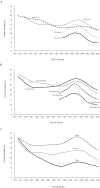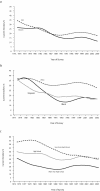Long-term trends in adolescent and young adult smoking in the United States: metapatterns and implications
- PMID: 18382001
- PMCID: PMC2374818
- DOI: 10.2105/AJPH.2007.115931
Long-term trends in adolescent and young adult smoking in the United States: metapatterns and implications
Abstract
Objectives: We sought to describe long-term adolescent and young adult smoking trends and patterns.
Methods: We analyzed adolescent data from Monitoring the Future, 1976 to 2005, and young adult (aged 18-24 years) data from the National Health Interview Survey, 1974 to 2005, overall and in subpopulations to identify trends in current cigarette smoking prevalence.
Results: Five metapatterns emerged: we found (1) a large increase and subsequent decrease in overall smoking over the past 15 years, (2) a steep decline in smoking among Blacks through the early 1990s, (3) a gender gap reversal among older adolescents and young adults who smoked over the past 15 years, (4) similar trends in smoking for most subgroups since the early 1990s, and (5) a large decline in smoking among young adults with less than a high school education.
Conclusions: Long-term patterns for adolescent and young adult cigarette smoking were decidedly nonlinear, and we found evidence of a cohort effect among young adults. Continued strong efforts and a long-term societal commitment to tobacco use prevention are needed, given the unprecedented declines in smoking among most subpopulations since the mid- to late 1990s.
Figures


References
-
- Office on Smoking and Health. The Health Consequences of Smoking. A Report of the Surgeon General. Atlanta, Ga: Centers for Disease Control and Prevention; 2004. - PubMed
-
- Centers for Disease Control and Prevention. Annual smoking-attributable mortality, years of potential life lost, and productivity losses—United States, 1997–2001. MMWR Morb Mortal Wkly Rep. 2005;54(25): 625–628. - PubMed
-
- Office on Smoking and Health. Women and Smoking. A Report of the Surgeon General. Atlanta, Ga: Centers for Disease Control and Prevention; 2001. - PubMed
-
- Office on Smoking and Health. Reducing Tobacco Use. A Report of the Surgeon General. Atlanta, Ga: Centers for Disease Control and Prevention; 2000.
-
- Eriksen M, Green L, Husten C, Pederson L, Pechacek T. Tobacco control in the United States. In: Ward J, Warren C, eds. Silent Victories: The History and Practice of Public Health in Twentieth Century America. New York, NY: Oxford; 2006.
Publication types
MeSH terms
Grants and funding
LinkOut - more resources
Full Text Sources
Medical
Miscellaneous

